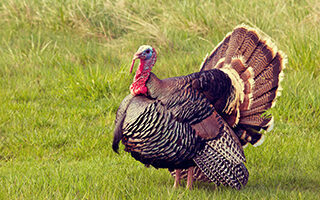
This week, we celebrate the turkey, that iconic symbol of American abundance that has become such a big part of people coming together each year to celebrate what they’re thankful for.
Did you know the ancestors of the turkeys many of us enjoy at Thanksgiving feasts were first domesticated in the regions we now know as Texas and Mexico? That’s right, Texans. Evidence shows native peoples in these areas raised turkeys for food at least 2,000 years ago.
Texas is known for three of the five known subspecies of wild turkey—the eastern, Merriam’s and the Rio Grande. The Rio Grande turkey is the most plentiful. It lives in central parts of the state, Mexico and parts of Oklahoma. Merriam’s turkey exists only in small pockets in the state’s panhandle. And the eastern turkey lives just where its name suggests—East Texas.
Wild turkeys in Texas were especially plentiful up until the late 1800s, when settlers began to move in. Overhunting and the loss of habitat took a serious toll on their numbers. And by the early 1900s, these birds were almost totally wiped out. Conservation efforts since then have helped, though habitat loss is still a threat. The Rio Grande turkeys of central Texas have had the most success bouncing back.
Wild Texas turkeys roam the countryside year round, eating nuts, seeds, berries and the occasional bug. They like open forests dotted with clearings and grassy areas at the edges of tree lines. You’re likely to see them in these places, or along wooded roadsides, feeding in the early morning hours.
In the fall and when it’s cool, they like to hang out in large flocks of hens and toms. Sometimes, you’ll catch them roosting in trees as the sun sets during this time of year. And in late winter and early spring, as turkeys get set to breed, you’ll see these groups start to break up and fuss and gobble.
Veteran Energy wishes all of you the happiest of Thanksgivings this year. We hope it’s a time of abundance and connections with family and friends.


